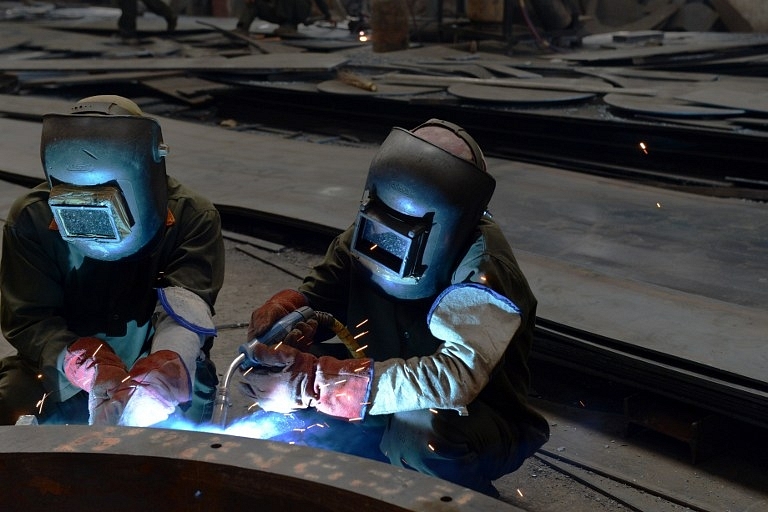Economy
Industrial Growth: There Is A Silver Lining, But The Clouds Haven’t Dispersed Yet

So what do the first quarter (Q1) numbers about the growth in industrial production in 2015-16 say about the Narendra Modi government’s handling of the economy? This is, after all, a bellwether sector.
On the face of it, the picture painted by the Q1 index of industrial production (IIP) data isn’t all that bright, unfortunately. Overall, production from India’s factories grew 3.2 per cent in Q1 of 2015-16, against 4.5 per cent in Q1 of 2014-15. The lower performance over last year cuts across sectors – mining, manufacturing and electricity – as well as use-based segments (basic goods, capital goods and intermediate goods).
This government’s many detractors will, obviously, go to town with these numbers. Now, since this government took charge only in the last week of May 2014, the Modi government cannot take credit for the 2014-15 Q1 performance. But it will be held to account for this year’s Q1 performance – there is simply no getting away from the fact.
The government can, however, take heart from two indicators. One, overall industrial production growth in the last six months has been the highest in the last three years, according to D. K. Joshi, chief economist at Crisil.
Two, there is a very faint revival in the fourth use-based sector – consumer goods – which had seen positive growth only in two months in 2014-15. Consumer goods production grew 2.4 per cent in Q1 of this fiscal against a decline of 3.2 per cent.
Within this sector, the consumer durables segment (refrigerators, televisions, washing machines etc), which stayed in the negative zone throughout 2014-15 (barring a meagre 3.6 per cent growth in May 2014) seems to be coming out of the woods. Against a 9.5 per cent decline in production in Q1 2014-15, there was a 3.7 per cent increase in Q1 this year. The consumer non-durables segment (the consumables) has also done better in Q1 this year, though only marginally – 1.6 per cent growth over 1.3 per cent in Q1 last year.
Is this enough to say, as finance minister Arun Jaitley does, that this is an indication that the country is firmly on the growth path?
Not quite.
Yes, the numbers indicate a fledgling consumer demand revival. But let’s not lose sight of the fact that the increase in the consumer durables segment came from a huge 16 per cent jump in production in June (growth was 1.2 per cent in April and minus 3.8 per cent in May) and this was on the back of a 23 per cent decline in June 2014. Also, the consumer non-durable segment is not on a sustained recovery path -– production grew only 1.3 per cent against 1.9 per cent in June last year, growth in May was minus 0.8 per cent. The better quarter performance appears pegged to the 4.2 per cent growth in April.
Growth in this fiscal will be led by consumer demand, says Devendra Pant, chief economist at India Ratings, but he warns against expecting this to lead to an early pick up in investments. There’s far too much excess capacity in industry, he points out.
Indeed, capacity utilisation is at an all-time low. The Reserve Bank of India’s Quarterly Order Books, Inventories and Capacity Utilisation Survey shows that capacity utilisation in Q4 of 2014-15 was only 75.2 per cent, slightly lower than the 76.2 per cent in Q4 of 2013-14. It had actually dipped in the first three quarters of 2014-15. Fresh investments will not happen till capacity utilisation reaches near-full levels, Pant points out. It is greenfield investments that will put the zing back in the economy and generate jobs. That’s not going to happen for a while.
Even the consumer demand revival is on slightly shaky ground. The RBI’s quarterly consumer confidence survey for June 2015 shows a dip in both the current situation index and the future expectations index – both had been increasing steadily since June 2014. The quarterly inflation expectation index for June shows an increase for three months ahead and one year ahead. So if people expect higher inflation, they will tend to hold back on spending, putting even consumer demand-led revival at stake.
The industrial sector is turning the corner; it has not turned it yet.
Introducing ElectionsHQ + 50 Ground Reports Project
The 2024 elections might seem easy to guess, but there are some important questions that shouldn't be missed.
Do freebies still sway voters? Do people prioritise infrastructure when voting? How will Punjab vote?
The answers to these questions provide great insights into where we, as a country, are headed in the years to come.
Swarajya is starting a project with an aim to do 50 solid ground stories and a smart commentary service on WhatsApp, a one-of-a-kind. We'd love your support during this election season.
Click below to contribute.
Latest